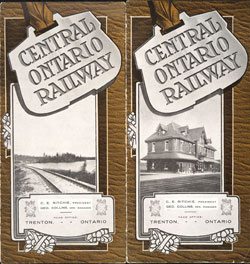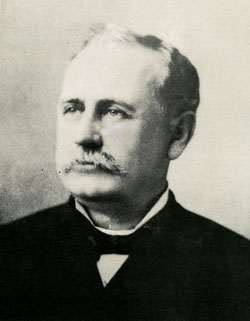Central Ontario RailwayReporting mark: COR
The Prince Edward County Railway was a late bloomer. Just north of the county, the GTR had been enjoying a successful run through Belleville for almost 20 years. Despite the obvious advantages of rail service, there was still strong opposition in the county.

Library and Archives Canada
Merrilees Transportation Collection
M-2386/nlc-3060
Nonetheless in 1873, County Council offered the two promoters, Charles Bockus and Col. Walter Ross, a generous subsidy of $87,500 to build a line from Trenton to a small fishing harbour of Long Point. The line was impractical in many respects, however before construction could begin, North America was hit by a massive stock market crash followed by a severe depression. Everything was put on hold for an indefinite period of time.
By 1878, with the subsidy close to expiring, demands for a railway began to head up again. The economy had improved to the point where the promoters began pressuring County Council to extend the deadline. The subsidy, while still generous, had already been reduced to $60,000. An amendment to the bylaw passed by one single vote, with the requirement that grading be completed by October 15, 1878. A little less than a year later, trains were running between Picton and Trenton.
In 1880, the railway was purchased by a local citizen, one George McMullen, a controversial figure at best. The Canadian-born McMullen had moved to Chicago at an early age and become an American citizen. He favoured annexation with the US and was more American than most Americans, including those who could trace their lineage back to the landing of the Mayflower. A staunch Liberal, he was deeply involved in the railway bribery scandal that brought down Macdonald's Conservative government in 1873. Despite all his baggage McMullen, who was also a talented inventor, returned to Canada with the full intention of taking an active role in the railway's development.

Hale Farm Museum, Akron Ohio
The McMullens' main interests were in mining, not railways. Railways were simply a means of transporting the riches that came from beneath the ground. Following an unsuccessful attempt to gain access to Madoc, George and his brother John (J.B), set their sites northward past Eldorado, once the scene of a major gold rush. Their base of operations also shifted northward from Picton to Trenton, a larger community with a promising future if the right infrastructure could be put in place.
One of the McMullens' most important contacts during this period was a prospector named William Coe. Coe went on to establish a number of successful mines in the area surrounding Coe Hill, named for one of his mines.
The McMullens had big dreams but until Coe started producing, they were strapped for cash. That problem was solved with the arrival of Samuel Ritchie, a wealthy American industrialist, who was recruited by the McMullens to explore iron mining opportunities in Hastings County. Ritchie would go on to develop a passion (some would argue an obsession) for the railway, often at the expense of far more profitable ventures.
The year 1882 was a bit of a banner year. The railway's name was officially changed to the Central Ontario Railway (COR). Ritchie was gradually emerging as president. William Coe announced the discovery of 2,600 acres of iron-ore. Both Coe and J.B. McMullen were elected to the Board of Directors.
Ritchie began his working life as a school-teacher. A flair for business led him to lumbering, railroading and manufacturing, first in carriages and then in sewer pipes. He also owned coal properties in West Virginia. Ritchie was between ventures after his sewer pipe factory burned to the ground in 1878.
Unlike his Canadian-born partner (known locally as George "Washington" McMullen) Ritchie was both admired and respected. Under his leadership, construction standards took a giant leap forward. The COR also began expanding. By 1884, another 72 miles (115 km) between Trenton Junction and Coe Hill was opened.
Ritchie's problems with the COR began in 1885 with the stunning news that Coe's big iron discovery was about the go bust. It turned out the sulphur content in the iron was far too high. At the time there was no known means of separating the two, rendering the iron unusable. Ritchie and the COR had invested heavily in the Coe Hill mine. Both were left in serious financial difficulty.
Next up was the first in a near endless series of back-to-back lawsuits. In 1886 Coe sued Ritchie for $50,000 over the purchase of shares. Ritchie countered with a $500,000 suit, alleging that Coe had misinformed him about the mine's resources.
One of the most damaging suits was filed by McMullen against Ritchie. McMullen had ostensibly departed back in 1885. He then reappeared with a vengeance, claiming Ritchie had agreed to buy stocks and bonds from them and never carried out the arrangement. In March 1888, McMullen received a legal attachment on the COR for $283,000.
Unknowingly, Ritchie's determination to save the COR would lead him into groundbreaking territory. He began by forming a business alliance with Senator Henry B. Payne and Judge Stevenson Burke of Cleveland and Thomas Cornell of Akron, Ohio. In 1885 he started investigating newly discovered copper deposits in Sudbury. At the insistence of his partners, the Sudbury properties were transferred to a newly formed corporation, the Canadian Copper Company (CCC). The remaining lands along the COR were transferred to another company, the Anglo American Iron Company (AAIC).
Much to everyone's surprise, the ore in the Sudbury properties showed a far greater presence of nickel than copper. At the time the market for nickel was limited. Ritchie's next challenge would be to find new markets for nickel along with a cost-effective means of smelting the ore.
By 1887 Ritchie's relationships with his business associates had become badly strained. Forced to rely on them for financial assistance to keep the COR operating, he began signing over bonds and shares as collateral. In some cases, largely due to administrative sloppiness, he didn't have clear title to all the securities. By 1891 the situation had deteriorated to the point of no return.
When it came to the CCC, Ritchie couldn't see the forest for the trees. In 1891 the CCC, along with the refiner Orford Copper, began receiving contracts from the US Military. Even in those early days, it was becoming apparent that there was huge potential for the newly-formed copper company. Instead Ritchie looked at merging the CCC, AAIC, and COR into one single company. His purpose was to compensate holders of the now-worthless Coe Hill stocks and infuse more money into the COR.
That was the point when Ritchie's horrified partners finally pulled the plug. They saw no reason to saddle the potentially profitable CCC with a couple of losers like the COR and Coe Hill Mines. Ritchie was publicly disavowed by his partners and booted out of the corporation.
Ritchie did not take his ouster lightly. He lashed back with a series of lawsuits and countersuits that dragged on for the better part of 10 years. It didn't seem to matter that Cornell passed away in 1892 and Payne in 96. The battles raged on bitterly between Ritchie, Burke, and the estates of his former partners. In November 1897 the courts ordered that Ritchie's assets be sold by judicial auction. They ended up being purchased by Burke and the Cornell and Payne estates.
Continually being outmaneuvered in the courts by his former partners and their estates, Ritchie was batting zero until 1901 when he was able to prove that Cornell's will had been forged by the executors. According to Ritchie's claim, his wife had purchased the stocks and bonds from the Cornell estate in 1897 four months before the court-authorized judicial auction.
Whatever else was going on with Burke and the Payne estate is not known. It has been speculated that the former partners intended to put the railway into receivership and then sell it for far more money than they lent Ritchie. Shortly after knowledge of the fraud became public, both parties offered to settle. In 1902 the CCC was reorganized as the International Nickel Company (INCO), which grew to become the second largest producer of nickel in the world. INCO is now known as Vale Canada.
Despite all the drama and turmoil, the COR still managed to expand. Under manager George Collins, the railway embarked on a number of modest initiatives. One was the Ontario, Belmont and Northern Railway Company (later known as the Bessemer and Barry's Bay Railway Company) a wholly owned subsidiary that built spurs to a number of mining properties.
In 1900 the COR opened an extension to Bancroft. It was followed in 1903 by a magnificent new station, head office and yards in Trenton. In 1907 the line was extended further north to Maynooth. The original intent was to connect with the Canada Atlantic Railway Railway (CAR) at Whitney, however that was never completed. Collins, who had joined the COR in 1882 as a clerk at the tender age of 22, had grown to become one of the most respected railway men in the industry.
The COR's fortunes were continually fluctuating. The success of the mines, the financial health of their other major customers which included the lumbering empires of the Rathbuns and Gilmours, all played a part. Unpredictably harsh winters, which could leave trains stalled on the tracks for days or weeks at a time, were also major factors. The Gilmours went bankrupt around 1900. Less than 10 years later, the Rathbuns followed suit.
Although the settlement was not the end of Ritchie's legal woes, he now had the upper hand and was able to weather further assaults on the railway. In 1905 the courts ruled that the bondholders had the right to sell the COR. Nothing happened once it became known that Mackenzie and Mann of the Canadian Northern Railway were beginning to purchase large blocks of shares.
In the meantime Ritchie and Collins set about rehabilitating the railway after years of deferred maintenance during the various litigations. Ritchie enjoyed a good relationship with Mackenzie and Mann, as did George Collins whose responsibilities and authority underwent a major boost.
By 1908 Ritchie had renewed his interest in the Sudbury properties. Sadly by then his health was failing. Severe rheumatism and diabetes had taken their toll. He passed away in 1908 at the age of 69, apparently a very wealth man.
In 1909, Mackenzie and Mann gained control of the Irondale, Bancroft & Ottawa Railway. It was extended to Bancroft where it connected with the COR. In 1910 it was leased to the COR with Collins being placed in charge of both railways. Also in 1910 they took over the Bay of Quinte Railway from the Rathbuns. Finally in 1911 they officially gained ownership of the COR which left them in a dominant position in southeastern Ontario.
The CNoR didn't survive past the First World War. A victim of overly rapid expansion and restrictive wartime financing, the CNoR was taken over by the federal government and nationalized. It became part of the newly formed Canadian National Railway (CN) in 1918. George Collins moved over to CN where he remained until his death in 1927.
Under CN ownership, the line remained active for many years. The most northerly section from Lake St. Peter to Wallace was abandoned in 1960. That was followed in 1965 by the section from Maynooth to Lake St. Peter. The rest of the line remained in use until 1984. Today only a small stub at Trenton Junction survives, where it's being used as a lowly siding to service a grain terminal.
